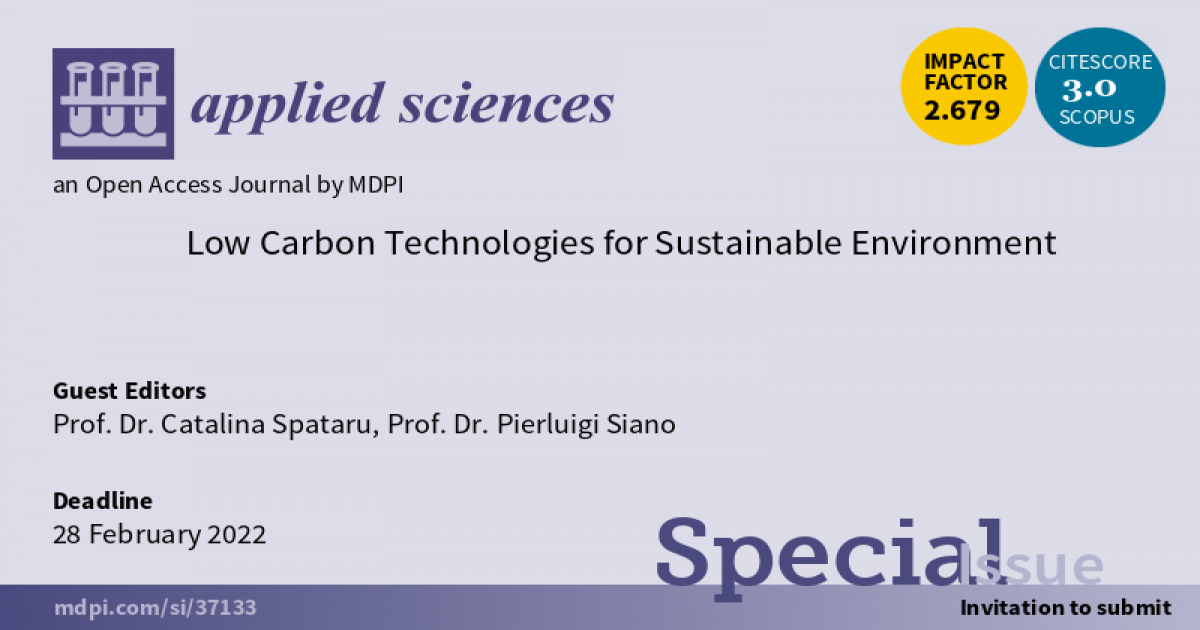Low Carbon Technologies for Sustainable Environment
A special issue of Applied Sciences (ISSN 2076-3417). This special issue belongs to the section "Environmental Sciences".
Deadline for manuscript submissions: closed (28 February 2022) | Viewed by 18876

Special Issue Editors
Interests: resource nexus (water–energy–land–food–materials); governance; scenarios analysis; sustainability; systems modelling
Special Issues, Collections and Topics in MDPI journals
Interests: smart grids; energy management; power systems; demand response
Special Issues, Collections and Topics in MDPI journals
Special Issue Information
Low carbon technologies (LCT) are key for further economic progress and stronger climate change mitigation ambition. Therefore, it is important to monitor progress towards LCT deployment and understand technological development and gaps.
This Special Issue of Applied Sciences aims at bringing together the most recent research activities in the area of low carbon technologies deployment in various sectors (industry, services, transport, etc.) and application of technologies to the challenges created by climate change.
The topics of interest for this Special issue include but are not limited to:
- Innovative and emerging new technologies;
- Hybrid technologies (e.g., solar thermal power and solar desalination; biogas and solar);
- Process optimization with carbon reduction in industry;
- Advancements in key components;
- Waste and electricity management;
- Techniques to improve efficiency and its reliability;
- Simulation, optimization, and analysis tools;
- Integrated approaches;
- Low carbon practices in the service and industrial sectors;
- Environmental impact mitigation;
- Low carbon power system (e.g., fuel cell power, advanced gas turbine power system);
- Waste to energy cycle system.
Prof. Dr. Pierluigi Siano
Guest Editor
Manuscript Submission Information
Manuscripts should be submitted online at www.mdpi.com by registering and logging in to this website. Once you are registered, click here to go to the submission form. Manuscripts can be submitted until the deadline. All submissions that pass pre-check are peer-reviewed. Accepted papers will be published continuously in the journal (as soon as accepted) and will be listed together on the special issue website. Research articles, review articles as well as short communications are invited. For planned papers, a title and short abstract (about 100 words) can be sent to the Editorial Office for announcement on this website.
Submitted manuscripts should not have been published previously, nor be under consideration for publication elsewhere (except conference proceedings papers). All manuscripts are thoroughly refereed through a single-blind peer-review process. A guide for authors and other relevant information for submission of manuscripts is available on the Instructions for Authors page. Applied Sciences is an international peer-reviewed open access semimonthly journal published by MDPI.
Please visit the Instructions for Authors page before submitting a manuscript. The Article Processing Charge (APC) for publication in this open access journal is 2400 CHF (Swiss Francs). Submitted papers should be well formatted and use good English. Authors may use MDPI's English editing service prior to publication or during author revisions.
Keywords
- Low carbon technologies
- Energy conversion and management
- Practices
- Environmental impact
- System modelling
- Energy conversion
Benefits of Publishing in a Special Issue
- Ease of navigation: Grouping papers by topic helps scholars navigate broad scope journals more efficiently.
- Greater discoverability: Special Issues support the reach and impact of scientific research. Articles in Special Issues are more discoverable and cited more frequently.
- Expansion of research network: Special Issues facilitate connections among authors, fostering scientific collaborations.
- External promotion: Articles in Special Issues are often promoted through the journal's social media, increasing their visibility.
- e-Book format: Special Issues with more than 10 articles can be published as dedicated e-books, ensuring wide and rapid dissemination.
Further information on MDPI's Special Issue polices can be found here.






